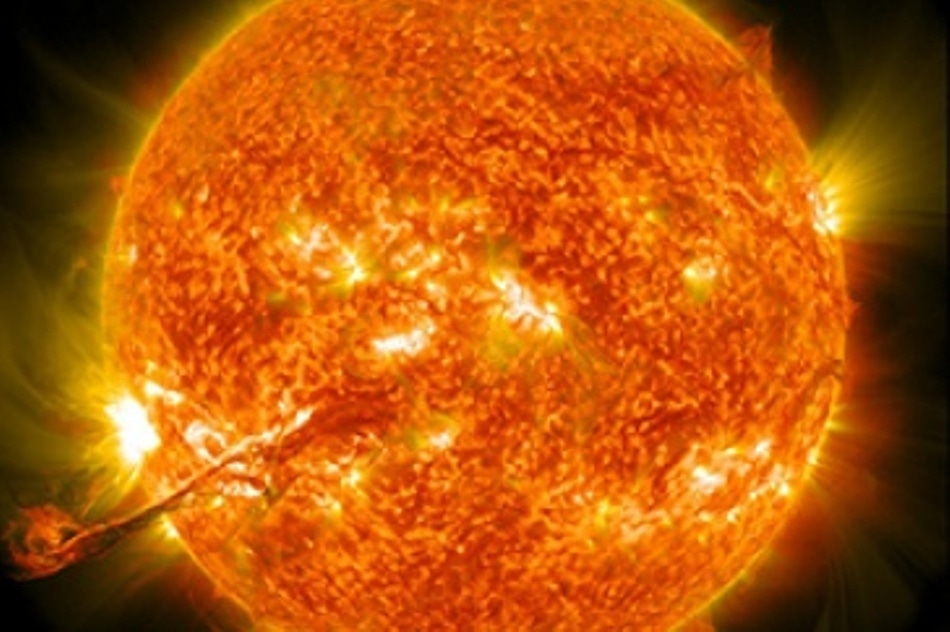Sep 3 2018
According to an old saying, every old thing is new again. Although the common saying usually refers to design, fashion, or technology, researchers from the University of New Hampshire have discovered that there is some truth to this saying even in relation to research.
 An image from NASA Solar Dynamics Observatory (SDO) satellite that shows an example of a commonly believed Slinky-like shaped coronal mass ejection (CME)—in this case, a long filament of solar material hovering in the sun’s atmosphere, or corona. This CME traveled 900 miles per second connecting with Earth’s magnetic environment and causing aurora to appear four days later on September 3, 2012. (Image credit: NASA/GSFC/SDO)
An image from NASA Solar Dynamics Observatory (SDO) satellite that shows an example of a commonly believed Slinky-like shaped coronal mass ejection (CME)—in this case, a long filament of solar material hovering in the sun’s atmosphere, or corona. This CME traveled 900 miles per second connecting with Earth’s magnetic environment and causing aurora to appear four days later on September 3, 2012. (Image credit: NASA/GSFC/SDO)
The researchers revisited some older data and found out new information on the shape of coronal mass ejections (CMEs) - large-scale eruptions of plasma and magnetic field from the sun - that could assist in protecting satellites in space and also the electrical grid on Earth someday.
Since the late 1970s, coronal mass ejections have been assumed to resemble a large Slinky - one of those spring toys - with both ends anchored at the sun, even when they reach Earth about one to three days after they erupt. But our research suggests their shapes are possibly different.
Noe Lugaz, Research Associate Professor in the UNH Space Science Center
It is vital to gain insights into the size and shape of CMEs since it can help better forecast when and how they will impact Earth. Although they are one of the principal sources for forming intense and splendid auroras, such as the Northern and Southern Lights, they also have the potential to damage satellites, disrupt radio communications, and cause great damage to the electrical transmission system causing long-lasting and massive power outages.
At present, there are only single-point measurements for CMEs, rendering it difficult for researchers to judge their shapes. However, these measurements have been handy to space forecasters, enabling them a 30- to 60-minute warning prior to the impact. The aim is to extend that notice time to hours - 24 hours at best - to make more informed decisions on whether it is necessary to power down satellites or the grid.
In their research, reported in Astrophysical Journal Letters, the scientists had a keen look at data from two NASA spacecraft, Wind and ACE, typically orbiting upstream of Earth. They investigated the data from 21 CMEs over a two-year period from 2000 to 2002 when Wind had been isolated from ACE. Wind had been isolated only 1% of one astronomical unit (AU), which is the distance from the sun to the Earth (93,000,000 miles). Therefore, rather than being in front of Earth currently, with ACE, Wind was perpendicular to the Sun-Earth line, or on the side.
Because they are usually so close to one another, very few people compare the data from both Wind and ACE. But 15 years ago, they were apart and in the right place for us to go back and notice the difference in measurements, and the differences became larger with increasing separations, making us question the Slinky shape.
Noe Lugaz, Research Associate Professor in the UNH Space Science Center
The data suggests a few other shape possibilities: CMEs are not just Slinky shapes (they could be deformed ones or something else completely), or CMEs are Slinky-shaped but on a considerably smaller scale (approximately four times smaller) than considered earlier.
The scientists stated that more research is required, and Lugaz stated that this information could be vital for future space weather forecasting. Since NASA and NOAA have been considering other missions, the team stated that this research demonstrates that future spacecraft may first have to analyze how close to the Sun-Earth line they have to be positioned to make useful and highly advanced forecast predictions.
This study was supported by NASA and the National Science Foundation.